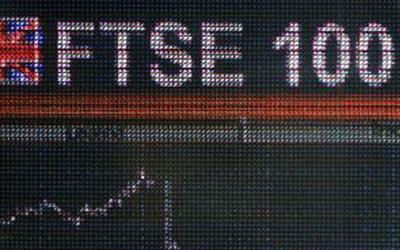In the second part of our introductory guide to CFD trading, we are going to walk through three worked examples of common CFD trades (Long Share, Short Share, and Long Index) to show you how CFDs work in practice.
Share CFD Example 1: Long Trade
 A long trade is a position that is opened with a buy in the expectation that the share price will rise.
A long trade is a position that is opened with a buy in the expectation that the share price will rise.
Apple shares are currently trading at 424.30 – 424.35. You have reason to believe that they will rise in value, so you place a buy trade on 10,000 units as a CFD at £4.2435. The total value of this trade would be $42,435, so with 10:1 leverage the initial margin would be £4,235.
With a dealer commission of 0.2%, the commission for this trade stands at 0.002 (0.2%) x £42,435 = £84.87.
Because you are trading CFDs (as opposed to buying actual shares) there is no stamp duty to pay – a saving of £212.18 (0.005 x £42,435)
Later in the week, your prediction proves to be correct and Apple shares rise to 433.50 – 433.55, so you decide to close the position, selling 10,000 Apple CFDs at £4.335 each. The commission for this trade is 0.002 x £43,350 = £86.70. Because you have held the position overnight, and it is a long trade, there will be a financing charge to pay.
Here’s how you calculate the profit for this trade:
Opening Level (ask price): 424.35p
Closing Level (bid price): 433.50p
Difference 9.15p
Gross Profit on Trade, (9.15p x 10,000) £915
Total Commission: £84.87 + £86.70 = £171.57
Financing Charge: £3.60
Net Profit: £739.83 (£915 – £171.57 – £3.60)
Share CFD Example 2: Short Trade
 A short trade is a position that is opened with a sell trade in the expectation that the share price will fall.
A short trade is a position that is opened with a sell trade in the expectation that the share price will fall.
Let’s say BP shares are currently trading at 469.80 – 469.85
You believe that BP shares are overvalued, and are likely to fall in value, so you place an order to sell 1,000 shares as a CFD at 469.8p. The total value of this contract would be £4,698. With 10:1 leverage, the initial margin would be £469.80, and the 0.2% commission would be £9.40 (£4,698 x 0.002)
Later in the week, your prediction is proved correct and BP’s share price falls to 440.20 – 440.25, so you decide to close the position. The commission for this leg of the trade would be £8.81. Because the position was left open over several nights, there will also be a financing charge, but because it is a short trade, this will be credited to you rather than charged.
This is how you calculate the net profit for this trade:
Opening Level (bid price) 469.80p
Closing Level (ask price) 440.25p
Difference: 29.55p
Gross Profit on Trade: 29.55p x 1,000 = £295.50
Total Commission: £9.40 + £8.81 = £18.21
Financing Charge: £2.20
Net Profit: £279.49 (£295.50 – £18.21 + £2.20)
Index CFD Trade Example: Long Trade
 Indices don’t usually come with a bid and ask price attached to them, but when they are listed on CFD platforms, they are assigned separate prices so that they can be traded as if they were a tangible underlying asset such as shares or commodities.
Indices don’t usually come with a bid and ask price attached to them, but when they are listed on CFD platforms, they are assigned separate prices so that they can be traded as if they were a tangible underlying asset such as shares or commodities.
Let’s say the FTSE 100 is trading at 4570 and the CFD platform is quoting a spread of 4567 – 4573 for this index. Because of the comparatively low volatility and high value of a single index CFD, it makes more sense to buy smaller quantities than you would with individual share CFDs, and use higher leverage to extract profits from the smaller movements.
Many CFD platforms do not charge commission on Index CFD trades, so we shall work on the assumption that there is no commission, but there will be a financing charge if you hold the position overnight (which we will).
You think the FTSE 100 is likely to rise, so you purchase 5 CFDs for £22835, which with 20:1 leverage would involve an initial margin of £1141.75.
The following week, the FTSE has risen to 4600, and the spread is now 4597 – 4603, so you decide to close the position.
Here’s how you work out the net profit for this trade:
Opening Level (Ask Price): £4,573.00
Closing Level (Bid Price): £4,597.00
Difference £25.00
Gross Profit on Trade, (£25 x 5) £125.00
Net Profit on Trade: £118.50 (£125 – £6.50 financing charge)
Next Steps
Ok, hopefully by now you’ll have a fairly clear idea of how CFDs work in practice. In the next installment, which will be published tomorrow, we shall be taking a look at the various types of trade order that you can place, and some of the more common strategies that are used to trade CFDs.
Other articles in this series:
Tradersdna is a leading digital and social media platform for traders and investors. Tradersdna offers premiere resources for trading and investing education, digital resources for personal finance, market analysis and free trading guides. More about TradersDNA Features: What Does It Take to Become an Aggressive Trader? | Everything You Need to Know About White Label Trading Software | Advantages of Automated Forex Trading








